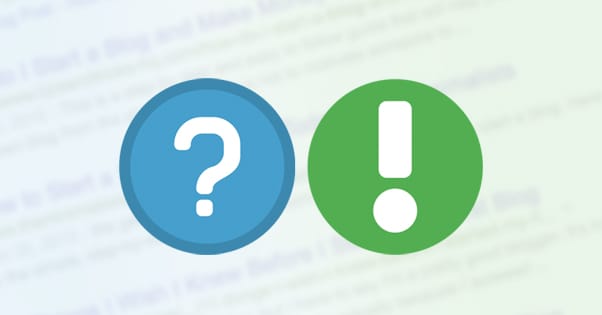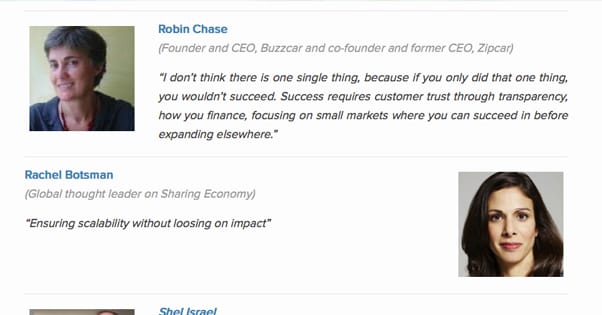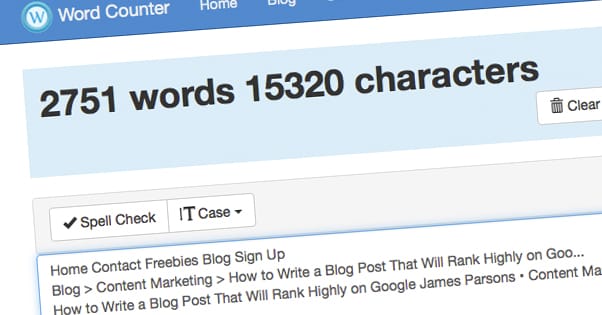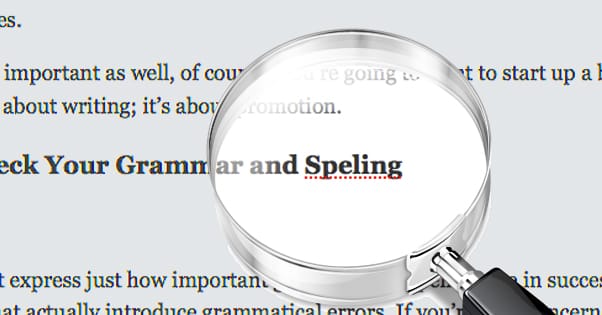How to Write a Blog Post That Will Rank Highly on Google
Published by James Parsons • Content Marketing • Posted July 10, 2015 ContentPowered.com
ContentPowered.com
The goal of almost every piece of content on the Internet is to be seen by as many people as possible.
No one piece of content has such widespread appeal that it will be relevant to everyone, though, so there are a lot of posts that rank highly for a lot of subjects, but there’s no one master post with everything for everyone. It would be ridiculous to have such a post, since it would be as large as the rest of the Internet.
Anyways, if you’re writing a post, you want it to rank on Google, because Google is the way most people find new content. The other method is through links from other pieces of content or social networks, and we’ll cover those as well. So; how do you write a kickass post that will rank on Google and perform flawlessly on your site?
Don’t Focus on Keywords
This is honestly my number one piece of advice.
If you want to write a post about, say, getting more views on your YouTube videos, just do it. Don’t try to figure out niche YouTube-related keywords you can cram into the post to rank for queries you’re barely related to. Don’t try to dig into keyword density. Google stopped providing most keyword data to discourage bloggers from relying on it, and I for one think that’s the best change they’ve made in a long time.
See, Google works by semantically parsing your content. They understand synonyms and grammar. They know variations on keywords exist, sometimes variations you never thought up. Your post can show up for a query where the exact words were never used in your content. The only thing a full focus on keywords will get you is a search penalty for keyword spam.
If you absolutely must use keyword research, use it to guide your topic and the direction you want the post to go.
Begin With a Question
Every good post begins with a question. In a figurative sense, that is. I don’t mean every first paragraph’s first sentence should end with a question mark. I just mean that there’s a question driving every post.
See, when someone goes to Google to look for something, they have a question. It might be “where can I get pizza at 5am on a Tuesday in New Jersey?” It might be “What’s the gross domestic product of Sierra Leone?” It might be “How can I write a blog post that’s guaranteed to rank high in Google results?” It might be “How do I replace the processor in my old Dell laptop?”
Every one of these questions has a different answer. The pizza question will prompt Google to provide a list of pizza places and their hours, sorted by distance from the searcher. The Sierra Leone question will typically bring up the Wikipedia page for the country. The Google question should bring up this post, and a few hundred thousand others. The laptop question brings up guides and tutorials.
The point is that every search begins with a question. To rank highly in the search results, you need to anticipate that question and provide the best, most useful answer possible. In some cases, it will be easy, because you’re an authority in that niche. In other cases, you have to go up against sites like Wikipedia, and you’ll never take first place.
If you’re not sure what questions are being asked, you can run searches on sites like Quora to see what people are asking. Keyword research helps show you what people are typing into their search engines, and you can come up with questions from there.
Determine Your Format
It might surprise you to know that the format of your post has a huge impact on how well it’s received. Lists are great. Tutorials are great. Big blobs of text with no focus and no progression are somewhat less great. Let’s go through various types of posts you can use to answer different types of questions.
- List posts are amazingly viral and can have fairly clickbait-style headlines without actually being clickbait, and thus earning the penalties that come from a clickbait title. 15 this, 23 that, top 100 of another thing; the list can be as long or as short as you like. I’ve seen successful Top 3 lists and I’ve seen successful top 200 lists. Buzzfeed, the king of low-content list posts on the Internet, has been analyzed to give you more detail about ideal list lengths.
- Guides and tutorials are another excellent type of post, primarily because they’re very useful, very actionable, and they last potentially forever. How long they last really depends on the subject of the tutorial. A tutorial on the exact processes for doing something in a piece of software is good, right up until the software updates and changes how it works. A tutorial for gardening will last longer, because gardening doesn’t change all that much. A tutorial for repairing a physical item is valuable for as long as that item exists and people want to repair it.
- Roundup posts are potent for a short time, but they’re not necessarily evergreen. They also tend to share elements with list, like “The Top 10 Industry Posts This Week.” They are, however, a good way to curate content, and to generate quality incoming links.
- You can also create your own post template and run with it. For example, Nick Scheidies of Income Diary wrote detailed profiles on a series of bloggers, analyzing what they do and what has made them successful.
- Detailed resources are great as well. For example, WordStream’s complete guide to PPC or Moz’s complete guide to SEO. These are evergreen, though they require upkeep, but they continue bringing in value basically forever.
Research and Outdo the Competition
Before you start writing, but after you’ve picked a topic and a format, do some research. Run some searches that a user might run to find your content, and look at what content is already out there. There’s going to be something, but if you’re lucky, nothing will be quite as relevant as what you’re planning to create. If you’re unlucky, there’s already a high quality post on the same subject ranking number one.
It’s going to be difficult to unseat the incumbent king, but it’s possible. You just need to adopt the attitude that you can one-up anyone and everyone. Examine what the existing post does, and resolve to do it better in yours. Do they include three authoritative sources? You should include five. Do they dig into data superficially? Dig deeper. Are they 1,000 words? Write 2,000. Do it better. Steal their throne.
Sometimes, this isn’t possible. Who in their right mind would try to write a better SEO guide than the one Moz has already? If you do, you could probably sell it as a $30 ebook. In these cases, it’s best to try to find more specific long-tail keywords and topics to cover, that don’t have the same level of dominance in their search results.
Aim for a Decent Word Count
You will note here that I did not actually specify a word count, and that’s because it can vary a lot depending on your site, your audience, your topic and your content.
For example, general wisdom suggests that Google dislikes short posts. They brand it “thin content” and penalize the sites that write them. On the other hand, you have people like Seth Godin writing posts anywhere from 50 words to 1,000 words, and you can’t say his blog is really penalized for it. It’s not even that he posts frequently to make up for it; he posts about once daily. Plenty of blogs do that with 1,000+ word posts every day.
Go to the opposite end of the spectrum and you have people who post once a week or less, but every post they make is a 2,500+-word juggernaut with a ton of valuable content and insight.
Buzzfeed posts lists with millions of views and they’re nothing more than a handful of subheadings and animated gifs.
You see the problem?
Write as much as it takes to create a high quality post. I do recommend at least 1,000 words, to make sure you’re out of the range of what Google would consider thin content, but you can make that determination yourself. You don’t need a lot of text for a “Top 10 Infographics” post, after all.
Cite Authoritative Resources
One of the keys to success with SEO is links. Most people talk almost exclusively about incoming links, or backlinks, when they think about the subject. There’s a lot of value to be had in linking out, though.
The first thing to do when you’re writing a post is pull up the most authoritative, best resources on the subject you can find. The second thing to do is pull up any sources of data you use in your calculations. These should be linked in your post. Data sources allow users to check facts and perform independent research. If you’re using your own data, you should publish it so other bloggers can use it in their own posts.
As for authoritative references, it’s always a good idea to link to them, primarily because of their authority. Many high profile blogs check the sites linking to them, and can link back to you when they discover your insightful and beneficial post. That’s why you want high quality content; it’s content the bloggers in question won’t be afraid to link to from their sites.
Backlinks are important as well, of course. You’re going to want to start up a blogger outreach campaign and try to build connections on social media to get your posts linked, but that’s not about writing; it’s about promotion.
Triple-Check Your Grammar and Spelling
Words cannot express just how important grammar and spelling are in successful blog posts. You can’t trust grammar checks, either. They tend to make suggestions that aren’t accurate or that actually introduce grammatical errors. If you’re ever concerned about the meaning of a word when you use it, look it up first. Read your post aloud if you have to, just avoid making any of the mistakes that ruin a post and make you look like a poor authority.
Impressions are everything. It helps to make your posts look compelling as well. In addition to images, which we’ll get to in a minute, you’ll also want to format your post properly. Subheadings every few hundred words are good. Bullet points and numbered lists, even within other lists, work. Don’t go insane and put a list inside a list inside a list, though.
A lot can be said here about tone and voice as well. If you’re running a daycare, you don’t necessarily want to sound like a corporate board member. You want a little more spring in your step, a little more energy, a more casual tone to get people to trust you with their children. Conversely, if you’re running a Fortune 500 company, you probably don’t want to sound like you’re outsourcing your blog posts to children in India.
I prefer a more casual tone, with a bit of first person thrown in. You’ll note that there’s no corporate doublespeak here, no “We at Blogpros” yadda yadda formality.
Finally, you can concern yourself with certain elements of blog design. You don’t want white text on a gray background. You don’t want size 4 font. You want readable text.
Add Compelling Images
You have all the basics of a good post once you’ve gotten this far, but you need something to really make it pop. That something, my friends, is images.
Now, the first thing you need to know when you’re thinking about images for blogs is to stay the hell away from Google image search. Unless you know how to use it properly, chances are any image you find through it is going to copyrighted, and you don’t want to use a copyrighted image on your site. I mean, sure, chances are nothing will happen if you do. On the other hand, literally nothing that can happen is good for you. Negative reviews, a poor social impression, a lawsuit; take your pick.
What you need to do is find images usable under creative commons, or images you can buy the rights to use. You can also create images of your own, if you have a graphic designer on staff or a decent quality camera. For creative commons, Flickr is a good site to search. Google’s image search works as well, but you have to specify usage rights under search tools. That’s what I mean about using it properly.
You can do two types of images in your posts. The first are the direct representations of what you’re writing about. For guides, tutorials, and the like, these are ideal. Screenshots or pictures of the process you’re describing make a world of difference for the value of a post.
The other type of image is the more symbolically interesting. That’s the kind of images I use most of the time, and you see a lot online. Look at any post about link building and there’s a 75% chance you’ll see a picture of chains somewhere. Chain links, right?
It’s often a good idea to adopt a distinct visual style and keep it consistent across your site. Jon Loomer does this, though I find it kind of weird to have his face and shades of gray and orange everywhere. Seriously, there’s 11 pictures of him on his homepage right now. Kind of creepy, Jon.
The point is, you want to be distinct and memorable, and images help to do that.
Once you’ve written your post, formatted it, and added images, it’s time to publish it. Check it for grammar and spelling again, and check for any errors in formatting or coding. You never know if you have an errant bold tag somewhere throwing things off.
Once you publish the post, it’s time to share it around. Make sure your sitemap reflects the presence of the new post for quick indexing, and share it on Google+ for another quick reference. Facebook and Twitter posts work as well.
The fact of the matter is, not every post you write is going to be a traffic generating powerhouse. Not all of them will top the search results. It takes a long time to build up the momentum you need to reach that level. It’s why big brands can coast along on their size, while small businesses have to struggle. That doesn’t give you an excuse to drop the quality of your posts, though. Rather, you need to maintain a high level of quality so that if one of your posts does make it big, anyone exploring the rest of your site will see a lot of other valuable pieces of content waiting for them. Then other posts receive the benefit, and your site as a whole grows.










